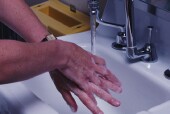- Skip Storing This Everyday Product in the Fridge Door
- Green Tea + B3 Pairing May Boost Brain Health
- Navigating Your Midlife Crisis: Embracing New Possibilities
- City Raccoons Showing Signs of Domestication
- Mapping the Exposome: Science Broadens Focus to Environmental Disease Triggers
- One Week Less on Social Media Linked to Better Mental Health
- Your Brain Changes in Stages as You Age, Study Finds
- Some Suicide Victims Show No Typical Warning Signs, Study Finds
- ByHeart Formula Faces Lawsuits After Babies Sickened With Botulism
- Switch to Vegan Diet Could Cut Your Greenhouse Gas Emissions in Half
If Kids Think Someone’s Watching, They’re More Likely to Wash Their Hands


Hand washing is one of the best ways to prevent infectious diseases, and placing cameras over sinks might boost youngsters’ hand hygiene, new research suggests.
The study included students at four public schools in a slum in Nairobi, Kenya. Video cameras were installed in hand cleaning areas outside the schools’ latrines. Teachers were told about the cameras and informed their students.
The Stanford University researchers also had in-person observers take notes about the students’ hand hygiene habits.
The video surveillance found that girls cleaned their hands 4 percent more often than boys, while the in-person observation found that girls were 3 percent more likely to do so. Both methods also found that students cleaned their hands longer when using soap and water than when using sanitizer.
Students at schools with soap and water were 1.3 times more likely to wash their hands when under video and in-person observation, than under in-person observation alone, according to the study published recently in the journal PLoS One.
Only 48 percent of students cleaned their hands when they were alone, compared to 71 percent when at least one other student was present. The likelihood of hand cleaning increased with the number of other people present, but there was a slight decrease when more than 10 were present.
The researchers said their findings suggest a number of ways to improve rates of hand washing among students in developing nations. These include: providing hand cleaning supplies in public washrooms; scheduling specific times for bathroom breaks between classes; creating student clubs to demonstrate and promote hand hygiene to classmates; and selecting certain students to be hand hygiene “champions.”
More information
The U.S. Centers for Disease Control and Prevention has more about hand washing.
Source: HealthDay
Copyright © 2025 HealthDay. All rights reserved.










